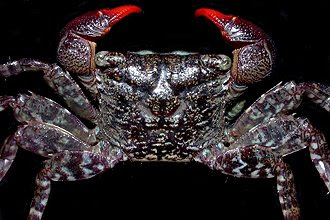Grace Chua, Straits Times 11 Jul 09;
WHEN they score a goal, football players whoop, turn somersaults or rip off their shirts and run around the field.
In the wild, animals have their own versions of the victory dance.
For instance, when male face-banded crabs win a fight against other crabs, they scrape one claw against the other to make low-pitched rasping sounds. By doing this, they're actually trying to show off their size and prowess to warn off potential challengers, a National University of Singapore (NUS) undergraduate found.
By doing this, they're actually trying to show off their size and prowess to warn off potential challengers, a National University of Singapore (NUS) undergraduate found.
Face-banded crabs or Perisesarma eumolpe, named for the bright blue-green band across their fronts, live in mangrove swamps in Mandai and Sungei Buloh.
Each male protects a half-square-metre plot of territory, jealously guarding the best hiding places, which protect him and his mates from predators like birds and monitor lizards.
In his thesis research, biology student Paul Chan observed the males locking claws to gain territory, and the winners of each battle performing their victory displays.
They would prop the tip of one claw on the ground and scrape up and down with the other, as though playing the cello vertically, he said.
Mr Chan found that crabs always used their bigger claw as the 'bow' - as though to show off their claw size and strength to the loser and other bystanders.
When both claws were the same size, they used the two interchangeably.
Previously, scientists thought the crabs' scraping also produced audible sounds that could be heard by other crabs out of sight.
But Mr Chan found that the crabs transmitted their message at a frequency nearly too low to be heard. He surmised that they sent their signals as vibrations through the ground, and that the larger their claws, the lower the frequency of the vibrations.
To test the theory, Mr Chan hopes to conduct lab experiments where he keeps an 'observer' crab out of sight of a winner-loser pair - and watches its reactions. The victory display, he added, could have other functions, such as attracting passing female crabs.
For the project, Mr Chan combined high-tech acoustic analysis of the crabs' sounds with 'old-fashioned field work, staring at crabs in the mud and chasing after them', said his adviser, NUS biology Professor Peter Ng.
'Paul is smart...to join the two and use them to better understand a phenomenon mooted decades ago but never proven. And the work has also challenged conventions on what the sounds do and how crabs register sound,' Prof Ng said.
Mr Chan, who graduated this week, will be doing his PhD at NUS, also likely on face-banded crabs. 'By looking at animal behaviour, we can learn about ourselves' in areas such as communication, he said.
When crabs perform their victory dance
posted by
Ria Tan
at
7/11/2009 05:22:00 PM
![]()
labels marine, shores, singapore, singapore-biodiversity, singaporeans-and-nature




